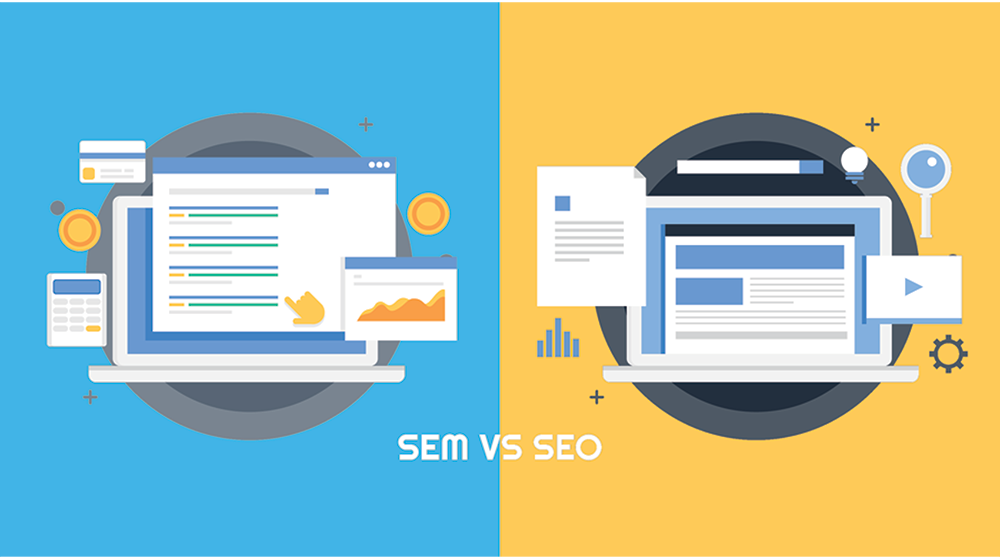
Get ready to rrruuummmbbbbllllleeee!
In this corner, weighing in with a reported 100 billion dollars annual earnings, Google’s massive pay-per-click behemoth Sponsored Traffic.
Facing off in this corner, comprising nearly 33% (per Net Marketshare), of all search engine traffic, with an admittedly superior click through rate and higher quality traffic, Organic SEO.
Ding. Ding. Ding. The bell rings and the smackdown to see how customers will locate your products and services is on. And the crowd (hopefully) goes wild.
Organic SEO and Sponsored SEM Traffic
Unless you have been living under a rock for the last decade or so, you have probably heard of Google. Google is, after all, the king of the mountain when it comes to searching the internet, handling roughly 80% of all search engine traffic on the web today.
While Bing, Yahoo, and Edge (Internet Explorer) do pull do down some internet search traffic, Google does most of the heavy lifting, handling around 5.5 billion searches per day. That breaks down to roughly 63,000 searches every second, according to Internet Live Stats, a team of researchers, analysts and developers who actively monitor the world wide web.
What is the Difference Between SEM and SEO and Which is Better?
As the planet’s leading search engine, Google has chosen to divvy up the SERP (search engine response page) pie by slicing it into two main segments. These are known as SEO, or search engine optimization, and SEM, or search engine marketing.
The main difference between them is that SEO rankings are free (won only by the sweat of your digital brow and value/relevance of your carefully crafted content), and SEM is sponsored, or paid for ads which are located above organically indexed search results.
In organic rankings, relevance is determined by Google using complex algorithms based on 200 plus factors as being most useful to the user. This means to rank, you need to know what trending keywords the user is looking for. Relevance, popularity, and recognized authority are all factored into the indexing system which Google uses to assign rankings.
SEM, on the other hand, as mentioned previously, is literally bought and paid for. Sponsored traffic ads elevated and promoted to visibility. They do admittedly, generate a large amount of traffic. But is it profitable traffic? Just because they land on your page, does not mean they are going to buy anything. Getting them there is only half the battle. Your content and copy still has to convert those visitors into paying customers.
Bear in mind that most people buy goods and services because they trust the source. According to a 2018 study by Search Engine Watch, organic SEO driven content is more trusted by people who are searching the internet in order to make a purchase. Consider that 92% of all search engine traffic runs off first page results; and 33% of all organic traffic goes to the site in the number one ranked spot. Which is why, even though it takes a lot of effort to rise through the ranks organically, it can pay higher dividends in the long run.
Speed Versus Ka-Ching
The big drawback to building organic traffic is that it tends to move with all the speed of glacial rush hour traffic. On average, it takes 3-6 months to begin to see organic SEO driven traffic percolate to the top. Once you get there, you still have to remain relevant or you will slide right back down faster than an otter belly-flopping on a greased slide. Getting and staying on top is literally a slugfest.
Which is why many companies hedge their bets with sponsored ads to boost web traffic. Sponsored SEM traffic, is a lot like tipping the hostess at an upscale restaurant to score a better table away from the swinging kitchen doors.
If you grease Google’s digital palm enough, they place you above organically occurring SEO results. Of course, that is going to cost you.
This is where it gets a little tricky. Purchasing your slot at the top of the page can pay off, if your conversion rate is high enough. Here is where understanding your click-through rate really matters. You also need to know which keywords are worth ranking on, and which are less effective. In other words, know your analytics. Simply having numbers is not enough. You need to understand them in a way that allows you to leverage them. Otherwise what’s the point?
If you create a pay-per-click campaign that takes you to the top of a hardly ever searched for keyword phrase, you can end up as the Grand High Poohbah of Jack Squat.
So, Which IS Better? Sponsored or Organic Traffic?
Like two bruisers who fight to a standstill with no clear winner, it may really come down to a draw because there is not likely to be a knock-out win on either side. Organic SEO driven traffic is more likely to provide high quality leads, but it really doesn’t hurt to add sponsored traffic too.
Some companies thrive with SEM driven traffic. Others focus almost exclusively on SEO driven organic traffic. Most do both. It all depends on your goals, brand, marketing strategy, and overall resources. Basically, it comes down to how deep your pockets are and how much time you must build your rankings.
Reaching the first page organically means creating and optimizing the heck out of your pages with high-value, readable content relevant to your ideal consumer. Sponsored traffic does not take as much time to generate and it allows you to carefully target your audience according to income, age, interests, education level, or other demographics.
Finding the balance is key. As the great boxer Muhammad Ali once said, “Float like a butterfly, sting like a bee.” The best plan then is to know your market, know your customers and cover your bases and knock out the competition with usable content and sponsored ads to generate traffic that wins hands down.